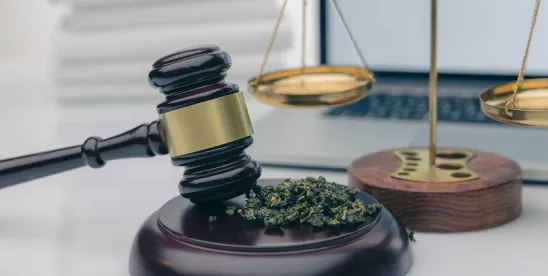When you live in the cannabis world, you have to keep your head on a swivel. While most areas of the law see incremental changes over years — if not decades — cannabis developments come by the day if not the hour.
In the latest example, the federal First Circuit Court of Appeals has become the OK Corral for two seismic issues in cannabis law. The cases at issue pit the federal government’s laws and policies against state-legal medical marijuana operators.
Que Sirois, Sirois
The first case challenges whether the Department of Justice has the authority to prosecute activities deemed legal by state law in light of a federal law commonly known as the Rohrabacher-Farr Amendment. As some Budding Trends readers may be aware, the Rohrabacher-Farr Amendment was first passed in 2014 as a last-minute addition to a major appropriations bill. The Amendment’s language has been renewed every year since and remains in effect today. The Amendment forbids the DOJ from using its resources to go after compliant state-sanctioned medical marijuana businesses and individuals even if they are technically violating federal law.
Although the Amendment bans the DOJ from using government funds to prosecute state-compliant medical marijuana operations, it does not on its face protect adult-use marijuana. The Amendment also does not suspend the federal Controlled Substance Act, nor does it make marijuana cultivation, sales, or use legal under federal law in states with medical marijuana programs. It has been, however, along with the since-rescinded Cole Memorandum, one of the cornerstones of the modern marijuana industry. The Amendment essentially codifies the handshake deal between the federal government and state-sanctioned medical marijuana businesses — allowing the latter to operate with much less fear of enforcement in spite of black letter federal law.
The Sirois case tests the boundaries of the protections afforded by the Amendment. In that case, the defendants allegedly operated a medical marijuana “collective” and sold marijuana on the black market, in violation of both state and federal law. Because the trial court’s opinion and the First Circuit appeal were deciding whether to stop the DOJ from prosecuting the defendants, Lucas and Alisa Sirois had the burden of proving that (more likely than not) they “substantially complied” with Maine’s medical marijuana laws.
The court found that the Siroises’ evidence was not enough to show “substantial compliance.” In doing so, it upheld a previous decision that stated that just because a medical marijuana operator has a valid license, the operator is not immune from prosecution for “blatantly illegitimate activity” that the state has rendered unlawful.
Although the Siroises have not been found guilty of any crimes yet, the Sirois case is important because it is now clearer that marijuana operators charged under federal law must make a substantial effort to show that any violations they are alleged to have committed were merely technical. The Sirois case is not currently set for rehearing, but the defendants have requested en banc review before the full First Circuit. Even if the Siroises’ motion for rehearing is not granted, it will be interesting to see whether this same issue reappears at a later date.
A practical takeaway: In our line of work, we hope to avoid dustups with federal agents if at all possible. Working on the front end with state and federal agencies to ensure a cannabis business is compliant with any applicable laws pays massive dividends in any recertification or enforcement action.
We doubt Sirois is a harbinger of a flood of federal prosecutions against state-sanctioned marijuana operations. Even though there will be a new federal government in place in the coming months, we note that the Amendment was largely followed in the first Trump administration, and we recently wrote that we did not expect the second Trump administration to significantly depart from recent federal marijuana policy (with a number of caveats in the that post, which is worth a read). The case is, however, a stark reminder to medical marijuana operators that compliance with state law should always be priority number one.
Boies Boies Boies
The second case, as we have written about before, asks the court to decide whether Congress has the authority under the Commerce Clause to regulate intrastate marijuana operations at all. We have been talking about this for almost two years. Even though we may not have guessed that this would be the case that could go the distance, it seems the first major challenge to Gonzales v. Raich could be presented to the High Court soon.
We previously wrote:
The federal government’s position is hard to take with a straight face. There may – and I stress “may” – have been a sufficient rationale at the time of the Raich ruling. But that ruling was premised on the fact that the government was affirmatively acting to stop marijuana activities around the country because the failure to do so would frustrate a national policy against marijuana transactions.
. . .
The reasoning of the Raich decision – regardless of whether it held water at the time – is obviously no longer valid. The Court’s central holding and rationale in that case should be overruled. Now, are there other valid reasons to support the right of the government to prohibit intrastate marijuana activity? That’s up to the government to prove.
On December 5, 2024, the First Circuit is set to hear oral arguments in what is now commonly referred to in cannabis circles as the “Boies Case.” We will be following this case closely because it could have far-reaching consequences for Controlled Substances Act enforcement, rescheduling, and state marijuana programs throughout the country.
Takeaways
The parties opposite the government in both cases are sort of making the same argument as Ike Clanton in the 1993 classic Tombstone: “Listen now, Mr. Kansas Law Dog. Law don’t go around here.”
How the First Circuit — and potentially the Supreme Court — ultimately resolves these two cases is important to marijuana policy and enforcement across the country. But perhaps more important to marijuana policy moving forward is the rationale employed by the court in its decisions. Will the court follow its relatively narrow decision in Sirois with a similarly narrow ruling in the Boies Case? Or will it dispense with one or both cases on the larger constitutional questions about the authority of the federal government to regulate state marijuana policy? And will the Supreme Court take up one or both cases and establish more conclusively the federal government’s authority to regulate state-sanctioned marijuana operations?





 />i
/>i
